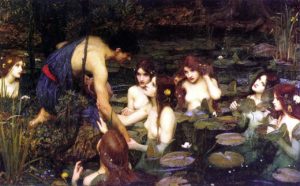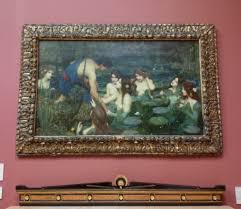By Philippa Anamoah-
After causing a stir amongst both artists and art lovers by deciding to remove one of their leading exhibits from their walls, Manchester Art Gallery has eventually returned the Hylas and the Nymphs (1869) painting to its usual position.
The famous painting by Victorian artist JW Waterhouse depicts seven naked water nymphs in a lily pond and a young Grecian named Hylas, who can be seen bending down to admire the mythical creatures.
GLORIFIED PORN
Some visitors argued that the painting of the nymphs WAs just a mode of glorified ‘soft porn’, whereas others believed that the artwork epitomises innocence and beauty. Upon viewing the artwork, the latter perspective is more conceivable because the nymphs are shown with wildflowers decorating their long flowing hair and their eyes lovingly fixating on the young

Waterhouse Hylas and the Nymphs Manchester Art Gallery 1896 (Google Images )
I had seen this pre-Raphaelite art piece, many times before in the gallery yet upon my visit last weekend, I saw that the piece was surrounded by an array of post-it notes, which contained thoughts and impressions from general public people towards the painting itself. These white square notes scattered across a wall in the pre-Raphaelite section were the main attraction in the gallery.
Amongst them were several doodle drawings of breasts, some were comments as some people simply drew a pair of breasts. Some people expressed how the painting was ‘misogynistic’ and ‘anti-feminist’, whereas some notes expressed ambivalence, with one reading, ‘why can’t we all just get along’.
Waterhouse’s painting was removed to create a conversation, as the gallery’s interim director Amanda Wallace stated,
“We were hoping the experiment would stimulate discussion, and it’s fair to say we’ve had that in spades – and not just from local people but from art lovers around the world. Throughout the painting’s seven-day absence, it’s been clear that many people feel very strongly about the issues raised, and we now plan to harness this strength of feeling for some further debate on these wider issues.”
Some visitors argued that the painting of the nymphs WAs just a mode of glorified ‘soft porn’, whereas others believed that the artwork epitomises innocence and beauty. Upon viewing the artwork, the latter perspective is more conceivable because the nymphs are shown with wildflowers decorating their long flowing hair and their eyes lovingly fixating on the young
I had seen this pre-Raphaelite art piece, many times before in the gallery yet upon my visit last weekend, I saw that the piece was surrounded by an array of post-it notes, which contained thoughts and impressions from general public people towards the painting itself. These white square notes scattered across a wall in the pre-Raphaelite section were the main attraction in the gallery.
Amongst them were several doodle drawings of breasts, some were comments as some people simply drew a pair of breasts. Some people expressed how the painting was ‘misogynistic’ and ‘anti-feminist’, whereas some notes expressed ambivalence, with one reading, ‘why can’t we all just get along’.
Despite not knowing at the time what had happened, it was quite clear that the gallery had initiated a topical discourse about the implications behind the depictions of the female body by male artists as well as the historical and patriarchal context surrounding paintings such as these.
Waterhouse’s painting was removed to create a conversation, as the gallery’s interim director Amanda Wallace stated,
“We were hoping the experiment would stimulate discussion, and it’s fair to say we’ve had that in spades – and not just from local people but from art lovers around the world. Throughout the painting’s seven-day absence, it’s been clear that many people feel very strongly about the issues raised, and we now plan to harness this strength of feeling for some further debate on these wider issues.”
This debate did not only exist in the form of a couple of hundred post-it notes on a museum wall but also a raging online controversy. Science-fiction Writer Annas Eskander declared the painting’s removal as “feminist extremism at its worst” and art critic from the Guardian Jonathan Jones protested the gallery’s actions stating,
“To remove this work art from view is not an interesting critique but a crass gesture that will end up on the wrong side of history. Even a kinky old Victorian perv has his right to paint soft-porn nymphs.”
In a society where political correctness is paramount in how we communicate and express ourselves, does that govern how we express ourselves artistically? Does the pushing forward of ‘artistic-correctness’ bring about moral virtue and development? Or does the removal of




